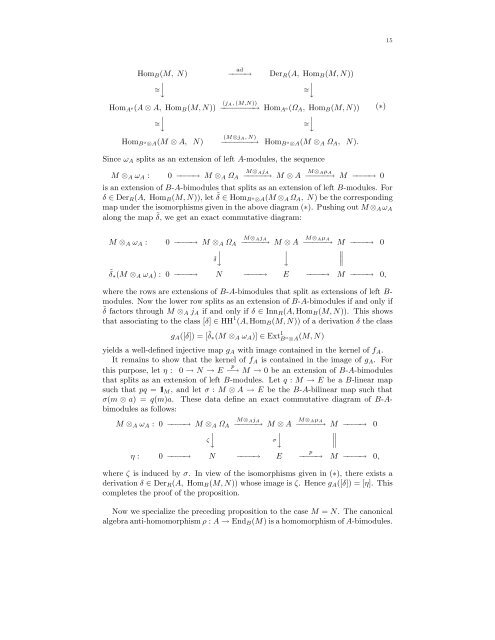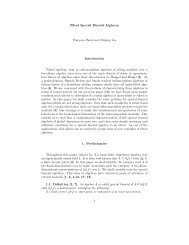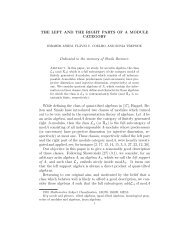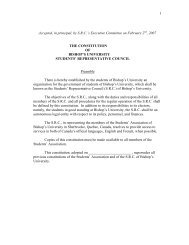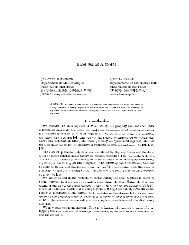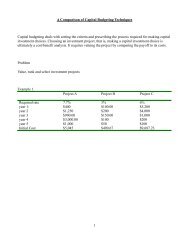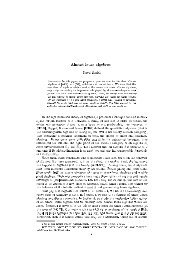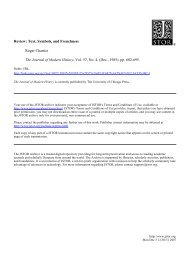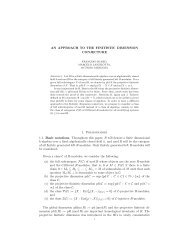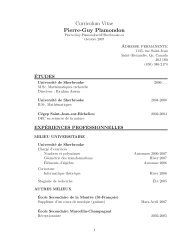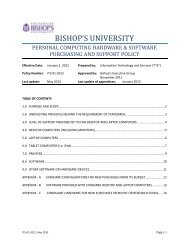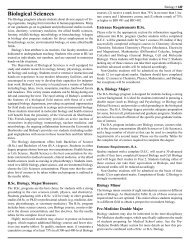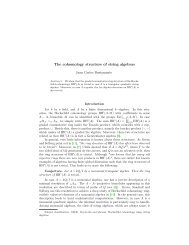Hochschild Cohomology and Representation-finite Algebras Ragnar ...
Hochschild Cohomology and Representation-finite Algebras Ragnar ...
Hochschild Cohomology and Representation-finite Algebras Ragnar ...
Create successful ePaper yourself
Turn your PDF publications into a flip-book with our unique Google optimized e-Paper software.
15<br />
Hom B (M, N)<br />
⏐<br />
∼ ⏐↓ =<br />
ad<br />
−−−−→<br />
Der R (A, Hom B (M,N))<br />
⏐<br />
∼ ⏐↓ =<br />
Hom A e(A ⊗ A, Hom B (M,N))<br />
⏐<br />
∼ ⏐↓ =<br />
(j A, (M,N))<br />
−−−−−−−−→ Hom A e(Ω A , Hom B (M,N))<br />
∼ =<br />
⏐ ⏐↓<br />
(∗)<br />
Hom B o ⊗A(M ⊗ A, N)<br />
(M⊗j A,N)<br />
−−−−−−−→ Hom B o ⊗A(M ⊗ A Ω A , N).<br />
Since ω A splits as an extension of left A-modules, the sequence<br />
M⊗ Aj A<br />
M ⊗ A ω A : 0 −−−−→ M ⊗ A Ω A −−−−−→ M ⊗ A<br />
M⊗ Aµ A<br />
−−−−−→ M −−−−→ 0<br />
is an extension of B-A-bimodules that splits as an extension of left B-modules. For<br />
δ ∈ Der R (A, Hom B (M,N)), let ˜δ ∈ Hom Bo ⊗A(M ⊗ A Ω A ,N) be the corresponding<br />
map under the isomorphisms given in the above diagram (∗). Pushing out M ⊗ A ω A<br />
along the map ˜δ, we get an exact commutative diagram:<br />
M⊗ Aj A<br />
M ⊗ A ω A : 0 −−−−→ M ⊗ A Ω A −−−−−→ M ⊗ A<br />
⏐<br />
⏐<br />
˜δ ↓<br />
↓<br />
M⊗ Aµ A<br />
−−−−−→ M −−−−→ 0<br />
∥<br />
˜δ ∗ (M ⊗ A ω A ): 0 −−−−→ N −−−−→ E −−−−→ M −−−−→ 0,<br />
where the rows are extensions of B-A-bimodules that split as extensions of left B-<br />
modules. Now the lower row splits as an extension of B-A-bimodules if <strong>and</strong> only if<br />
˜δ factors through M ⊗ A j A if <strong>and</strong> only if δ ∈ Inn R (A, Hom B (M,N)). This shows<br />
that associating to the class [δ] ∈ HH 1 (A, Hom B (M,N)) of a derivation δ the class<br />
g A ([δ]) = [˜δ ∗ (M ⊗ A ω A )] ∈ Ext 1 B o ⊗A (M,N)<br />
yields a well-defined injective map g A with image contained in the kernel of f A .<br />
It remains to show that the kernel of f A is contained in the image of g A . For<br />
this purpose, let η : 0 → N → E −→ p<br />
M → 0 be an extension of B-A-bimodules<br />
that splits as an extension of left B-modules. Let q : M → E be a B-linear map<br />
such that pq =1I M ,<strong>and</strong>letσ : M ⊗ A → E be the B-A-bilinear map such that<br />
σ(m ⊗ a) =q(m)a. These data define an exact commutative diagram of B-Abimodules<br />
as follows:<br />
M⊗ Aj A<br />
M⊗ Aµ A<br />
M ⊗ A ω A : 0 −−−−→ M ⊗ A Ω A −−−−−→ M ⊗ A −−−−−→ M −−−−→ 0<br />
⏐<br />
⏐<br />
ζ↓<br />
σ↓<br />
∥<br />
η : 0 −−−−→ N −−−−→ E<br />
p<br />
−−−−→ M −−−−→ 0,<br />
where ζ is induced by σ. In view of the isomorphisms given in (∗), there exists a<br />
derivation δ ∈ Der R (A, Hom B (M,N)) whose image is ζ. Hence g A ([δ]) = [η]. This<br />
completes the proof of the proposition.<br />
Now we specialize the preceding proposition to the case M = N. The canonical<br />
algebra anti-homomorphism ρ : A → End B (M) is a homomorphism of A-bimodules.


